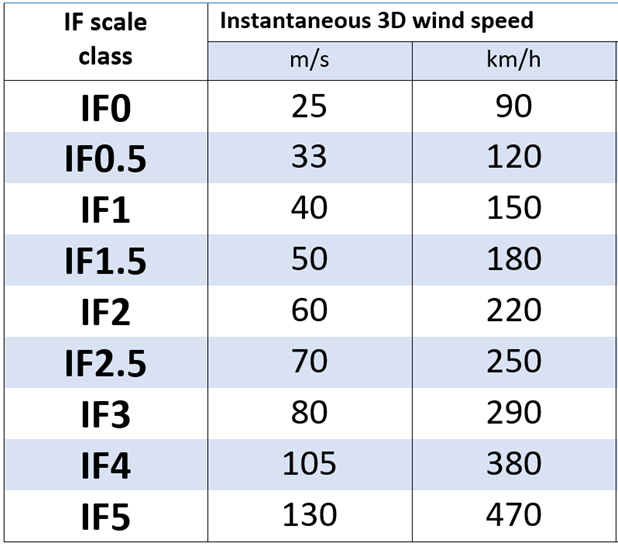Difficulties applying existing tornado wind speed scales to tornado and wind damage events in Europe, ESSL has since 2011 discussed an alternative for the original Fujita scale that has still been used in the European Severe Weather Database (ESWD).
In collaboration with partners from weather services, engineering, and forestry, a draft version of the International Fujita scale was presented on 8 May 2023 at the European Conference on Severe Storms in Bucharest, Romania
A first full version of the IF Scale was published on 28 July 2023:
Version 1.0
The first version of the IF-scale is now available here.
Frequently asked questions
What are some important characteristics of the IF-scale?
The scale uses the concepts of types of objects, called Damage Indicators (DI), having sustained a certain Degree of Damage (DoD) and assigns a unique rating to each combination of DI and DoD. This approach was copied from the Enhanced Fujita scale.
The scale provides estimates for the wind speed responsible for each rating using the speeds of the original Fujita scale, however with the understanding that the wind speeds are instantaneous three-dimensional speeds at the height at which the damage occurred. This contrasts with typical horizontal three-second average wind measurements at 10 m AGL used by other scales. In conditions outside of tornadoes, instantaneous wind speeds are about 20% higher than three second averages, but within tornadoes the difference may be much larger.
The scale allows for half steps on the Fujita scale until F3. Possible ratings are IF0, IF0.5, IF1, IF1.5, IF2, IF2.5, IF3, IF4, and IF5. The wind speeds of a given step on the scale are given using rounded values of the approximate instantaneous wind speed. The wind speed range covered by the IF0 through IF5 steps correspond well to the speeds measured in tornadoes by mobile Doppler radar.
Why is the IF-scale introduced?
The scale is introduced because there was no wind damage scale that could easily be used in Europe: The original Fujita- and T-scales give too little guidance on how to rate particular damage, and do not take into account recent knowledge of wind damage effects, while the Enhanced Fujita (EF-) scale has been developed specifically for typical structures in the United States and is difficult to apply elsewhere. In addition, important types of damage and wind measurements are not considered in the EF-scale.
What will happen to old tornado and wind damage cases rated using the F- or T-scale?
In the European Severe Weather Database (ESWD), new tornado reports are to be rated using the IF-scale starting in August 2023. Old reports will keep their rating on the F-scale (and in some cases, T-scale). Past events that were rated with the F-scale may be re-rated by ESSL and its partners using the IF-scale after a careful review.
How is a tornado or local wind event rated using the IF-scale?
A tornado or local wind event is given a maximum rating based on the maximal intensity it attained, as estimated from the worst damage it produced, or the highest wind speed measurement. In the ESWD it will be required to indicate the combination of a Damage Indicator and a Degree of Damage the maximum that a rating was based on. Survey teams are strongly encouraged to compile a full list of georeferenced Damage Indicators, so that a more complete picture of the damage footprint can be reconstructed. ESSL is working on developing an app to help simplify this work.

